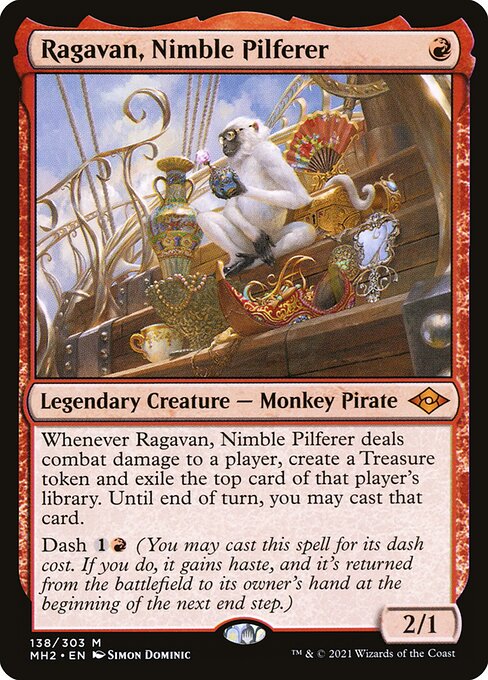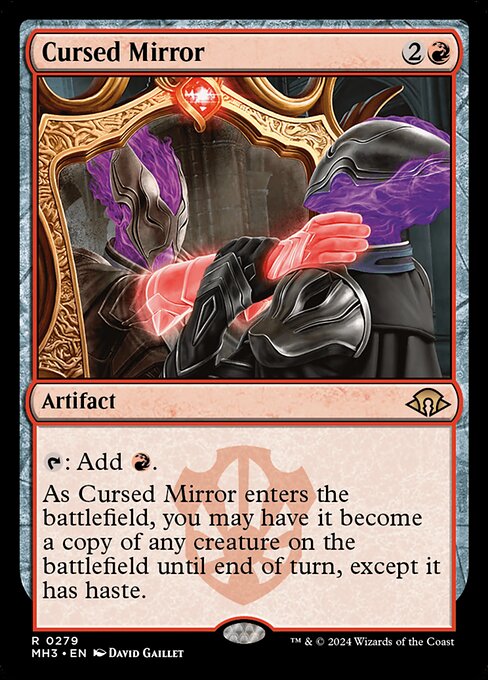Cover image: Harvest Season by Shreya Shetty
It’s the start of a new year, which means for us pessimists and nostalgists that it’s a wake for the old year, a time to revive grudges and revisit grief and generally be a nuisance. That’s alright—whatever gets you through the year and into the next one. I’m not ashamed to say that Magic has been part of what does just that, particularly during the last few years. One of Magic’s under-appreciated strengths is the fact that it breaks time into 2-4 month chunks, with each season generally home to a set or a major tournament series, thus making it an easy way to revisit and relive a year.
If we ever want to revisit 2021—big if, as I’m struggling to recall much good that came out of this grueling year—we’ll need a time capsule, a way of boiling down 365 days and 2,000 new cards into a scant handful of memories. Out of the context of their sets, these cards may appear alien or incomplete, but that’s part of the fun of a time capsule. Sometimes it’s complete junk, sometimes it’s treasure, but there’s always an inclusion to puzzle over. These aren’t necessarily my favorite cards of the year, but they’re the ones that serve as functional incarnations of their respective sets. Here, then, in 2021 in an (immediate mulligan) opening hand:

Kaldheim’s face card was Valki, God of Lies/Tibalt, Cosmic Impostor. Valki is a one-to-one Magic transliteration of Loki—a trickster god who wears disguises and befuddles their opponents. We’ve had double-faced modal cards for a year and a half now; I think they’ve proved their lasting worth. They train new players to build and play better, they reward more established players’ decision trees, they’re exciting on first glance and comforting after hundreds of games.
Zendikar’s double-faced cards smoothed mana curves, but they weren’t necessarily thrilling on paper. Valki/Tibalt, our first castable-backside double-faced Planeswalker, gave us many thrills; most memorably, the swiftly-addressed ability to come into play off a three-mana Cascade spell. I had a lot of fun while that lasted, and learned firsthand why that interaction had to go. More than Vorinclex, Monstrous Raider or Alrund’s Epiphany or Tibalt’s Trickery, the little Brain Maggot that could embodied Kaldheim: quirky, cruel, and unexpected.

Strixhaven gave us Learn/Lesson cards, of which only a couple made the jump to Constructed play (and don’t function in Commander without house rules). Still, they were spectacular in Limited, where the opportunity cost of picking up a spare Lesson or four was minimal and the ceiling was very high. Having a pseudo-wishboard accessible in Limited is a huge advantage, particularly when the Learn cards are reasonably priced and the Lessons are relevant but narrow and, in a worst case scenario, you can at least rummage away a spare land to draw a new card. Most of the twenty-one Learn spells are humble—your standard slate of combat tricks, overpriced removal, a decently-statted creature or two at higher rarities—but the cautious design was a good choice. Having access to options, particularly when they don’t come at a deck building cost beyond taking up a sideboard slot or three, makes decks stronger in a very organic way.
Learn may have shown up infrequently, with only two cards showing up at high levels in Constructed, but one card defined the mechanic: a simple bounce variant with subtle advantages. Divide by Zero may not be able to bounce a Treefolk token or counter a Pact of Negation, but it does everything else a control deck wants to do—stifle an opponent’s plans long enough to claim some breathing room and a free follow-up spell. I considered newly-minted staple Expressive Iteration or one of the disappointing Elder Dragons, but Divide by Zero is just too perfect for the scholastic set.

Modern Horizons can only be Ragavan, Nible Pilferer, who beautifully lands one rung below “tournament scourge” at “omnipresent pest.” Ragavan simply does too much for too little. I don’t think this polarizing card is worth banning in Modern; but like Lurrus of the Dream-Den, Dragon’s Rage Channeler, and (in a different world) Dauthi Voidwalker, it’s part of a trend of cards that are consistently above-rate.
The Evoke Elementals are similarly overpowered, but they’re more of a failed experiment than Ragavan, who is fair card with the dials cranked all the way up. There is no new territory with Ragavan, a familiar Legend who mashes up two years-old mechanics on a Jackal Pup body. I’d love to give this slot to Urza’s Saga, which is the perfect dialectic between “elegant” and “absurdly complicated”—the elegance of that typeline! the story it tells of extractive practices and technological advancement as it ticks up to Strip Mine you! the sheer block of text!—but the obnoxious little monkey cannot be denied.

Adventures in the Forgotten Realms was in many ways headed by Tiamat, both in the sense that she’s a mythical character in the game system and in the sense that she’s wordy and underpowered like so many of the set’s cards. That said, no card defines the crossover set to me like the Class enchantments—midway between Level Up cards and Sagas, these Enchantments let you sink unused mana into leveling up your commitment to a certain class archetype.
It’s a bit of a cheat to pick these fourteen cards instead of just one, so let’s give the nod to Ranger Class, which has seen heavy play. Hopefully, these go the same route as Curses, returning periodically as a subtype of enchantments. I would be very surprised to not see them back in Commander Legends 2.

Innistrad: Midnight Hunt brought back an old friend in a new guise: Wrenn and Six has run roughshod over Modern and Legacy for the last couple of years (until she was banned in Legacy), but our first Standard-legal Wrenn and Seven is the highlight of Midnight Hunt. It revealed so much about Standard rotation: Esika’s Chariot went from unplayed to a pillar of Standard, particularly with the “Chariot, next turn Wrenn and Seven, make a Treefolk, crew the Chariot the Treefolk, copy the Treefolk” line of play.
Wrenn has the vibe of a Commander ‘walker, but they’re a fantastic top end for Standard as well, offering massive card advantage and a threat factory. The Meathook Massacre may show up at casual tables for longer than the Planeswalker duo, but Wrenn and Seven made an immediate impact on tournament Magic—and were all but unbeatable in Limited.

Innistrad: Crimson Vow left me cold—perhaps suitable for an undead wedding—mostly because it continued a trend I’ve railed against throughout 2021: the phrase “once a turn.” Welcoming Vampire is a nice update of Mentor of the Meek, but that cursed phrase really restricts the fun. Dramatic Finale, Varis, Silverymoon Ranger, Anje, Maid of Dishonor, Beledros Witherbloom—these could quickly spiral out of control, but could also be cores of new archetypes, save for that “once a turn” phrase. Welcoming Vampire’s stats are decent for the cost, but that tantalizingly card draw ability feels awful when you cast Lingering Souls or think you’re being clever with Blink effects.

Commander is a movable feast these days. Aside from the larger annual drop of Commander decks, the cards seeded in Set and Collector boosters and the new Commander decks with each set mean that we have over two hundred unique cards to choose from. Demonstrate was a flop, the dice rolling of the AFR decks randomized outputs past my comfort level, and the official “Commander 2021” decks from Strixhaven were pretty insular. But there was one card released in 2021 that has “staple” on every line: Cursed Mirror. A mana rock early on and a surprise Clone with haste later on? It does it all, and even has “may” appended so you don’t have to. I’ve enjoyed a handful of the Commander cards this year, but none so much as the Mirror.
Turning the Page
In terms of larger takeaways, 2021 was a year that smoothed out the game. Foretell, Learn, Classes, modal cards, Blood tokens—all of these are ways to facilitate optimal turns, where you see the most cards and spend your mana most efficiently. This is part of why Adventures in the Forgotten Realms sticks out so intensely—introducing randomness and go-wide strategies goes against the general trend of the year. The best-of-one formats on Arena necessitate design trends to streamline play and drive engagement on the app.
So far, Alchemy aside, Wizards has done so by: a) making maindeck options more flexible with alternate modes (Bloodline Culling, Rip Apart, Wildshape), b) making the sideboard more accessible (Learn, Wish, The Raven’s Warning), and c) increasing deck velocity so players can see answers more consistently and readily (Blood tokens, Scrying, tutors). Magic in 2021 was about getting players to play more games of Magic more quickly and seeing more of their strategies than before. It’s feasible, after a full year of modal cards and transforming cards, to play a Standard deck completely comprised of double-faced cards and basic lands. Frankly, it was a great year for Magic—I haven’t even touched on my favorite set of the year, Time Spiral Remastered.
This may sound like sour grapes, but I mean it sincerely: more than anything, 2021 was the year where I finally got overwhelmed by Magic. This is a good development. I no longer feel the need to memorize almost every card from each set. My recent Commander games have slowed down—I’ve needed to say “Okay, now what’s that do again?” more frequently than ever, which may also be a product of age and pandemic burnout.
I used to have a working knowledge of card prices—at least what was going up or plummeting—but between Secret Lairs, swings in crypto, and the speed at which Twitter and Reddit accelerate buyouts, I have no clue what many cards are worth any more. It’s freeing. More than that, it’s joyful: when I started playing this game, back in 1997, I had no idea what the cards were or what they were worth. Now, twenty-five years later, I’m returning to that state of innocence.
Part of maturation, it seems to me, is filtering out the signal from the noise, is consistently determining “what matters” versus “what’s present.” If you’re a Limited player, that’s every Instant-speed trick; if you’re a Commander player, that may be a subset of cards relevant to your chosen generals. If you’re a bit of both, like me, it means learning to discount the tidal wave of new cards, reskinned favorites, and reprints, and accept the mystery with each new game.
A lifelong resident of the Carolinas and a graduate of the University of North Carolina, Rob has played Magic since he picked a Darkling Stalker up off the soccer field at summer camp. He works for nonprofits as an educational strategies developer and, in his off-hours, enjoys writing fiction, playing games, and exploring new beers.

